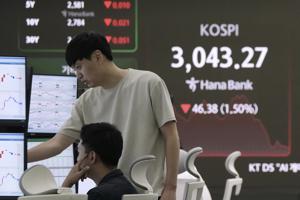NEW YORK (AP) — U.S. stocks experienced a mixed session on Wednesday, as Wall Street’s recent rally showed signs of slowing ahead of a crucial jobs report due on Thursday. The S&P 500 edged up by 0.1% in morning trading, following its first loss after reaching consecutive all-time highs. Meanwhile, the Dow Jones Industrial Average fell by 131 points, or 0.3%, and the Nasdaq composite gained 0.5%.
Treasury yields displayed mixed movements in the bond market, reflecting investor anticipation for the forthcoming report, which will reveal the number of jobs created and lost by U.S. employers last month. The general expectation is that hiring outpaced layoffs, albeit at a slower pace than in May. However, a surprisingly weak report released on Wednesday morning has sparked concerns that the official numbers may disappoint.
ADP Report Raises Concerns
The ADP National Employment Report indicated that U.S. employers outside the government sector cut 33,000 jobs in the previous month, contrary to economists’ forecasts of a 115,000 job increase. According to Nela Richardson, chief economist at ADP, “Though layoffs continue to be rare, a hesitancy to hire and a reluctance to replace departing workers led to job losses last month.”
While the ADP report does not always align perfectly with the U.S. government’s more comprehensive jobs report, it has nonetheless heightened anxiety over the potential outcomes of Thursday’s data. Concerns are further compounded by the ongoing uncertainty surrounding President Donald Trump’s tariff policies, which could lead employers to pause hiring activities.
Tariff Uncertainty and Economic Implications
Many of Trump’s proposed tariffs on imports are currently on hold, with implementation scheduled for the coming week. The tariffs’ potential economic impact remains uncertain; they could either exacerbate inflation and economic strain or, at the very least, contribute to market volatility. This uncertainty alone may be enough to deter hiring and investment.
Additional factors potentially affecting the job market include the U.S. government’s termination of protected status for 350,000 Venezuelans, which could result in a reduction of 25,000 jobs, according to Goldman Sachs economist David Mericle. His forecast for Thursday’s report is notably more conservative than those of many peers.
Market Reactions and International Indices
In the bond market, the yield on the 10-year Treasury rose to 4.29% from 4.26%, while the two-year Treasury yield, which is more sensitive to Federal Reserve interest rate expectations, dipped to 3.76% from 3.78%. A weaker-than-expected jobs report could prompt the Fed to consider cutting interest rates, a move that would potentially stimulate economic growth.
On Wall Street, Tesla shares rose by 3.1% after the company announced it delivered nearly 374,000 Model 3 and Model Y vehicles last quarter, surpassing analyst expectations despite a significant year-over-year decline in sales. Concerns have been mounting that CEO Elon Musk’s political engagements may be deterring potential buyers.
Constellation Brands saw a 2% increase in its stock despite reporting lower-than-expected quarterly profits. The company, which owns Modelo beer and Robert Mondavi wine, attributed the slowdown in job growth within the construction industry and other high-calorie sectors to reduced demand for its products. Nevertheless, it maintained its financial forecasts for the upcoming year.
In contrast, Centene’s stock plummeted by 38.1% after the healthcare company withdrew its profit forecasts for the year, citing preliminary data indicating worsening sickness trends in several states where it operates.
Global Market Movements
Internationally, stock market indices showed mixed results as the July 9 deadline looms for trade negotiations involving Trump and other countries. France’s CAC 40 increased by 0.8%, and Hong Kong’s Hang Seng rose by 0.6%. Conversely, Japan’s Nikkei 225 fell by 0.6%, and South Korea’s Kospi dropped by 0.5%.
The upcoming jobs report is expected to provide critical insights into the current state of the U.S. economy, potentially influencing both market sentiment and Federal Reserve policy decisions. As investors brace for the data release, the broader implications for economic growth and stability remain a focal point of discussion.
 Bryan Kohberger to Plead Guilty in University of Idaho Stabbings, Avoiding Death Penalty
Bryan Kohberger to Plead Guilty in University of Idaho Stabbings, Avoiding Death Penalty Sean ‘Diddy’ Combs Acquitted of Major Charges, Faces Decade in Prison
Sean ‘Diddy’ Combs Acquitted of Major Charges, Faces Decade in Prison Hamas Open to Ceasefire as Netanyahu Rejects Role in Postwar Gaza
Hamas Open to Ceasefire as Netanyahu Rejects Role in Postwar Gaza US Withholds Key Weaponry from Ukraine Amid Arms Shipment Pause
US Withholds Key Weaponry from Ukraine Amid Arms Shipment Pause Chinese Nationals Charged with Espionage Against US Navy
Chinese Nationals Charged with Espionage Against US Navy